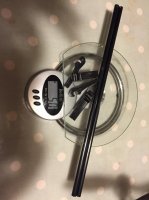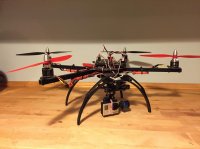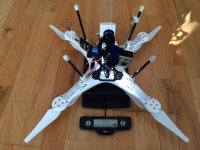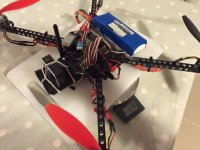You are using an out of date browser. It may not display this or other websites correctly.
You should upgrade or use an alternative browser.
You should upgrade or use an alternative browser.
Horrendous flight time!!
- Thread starter cliofreak
- Start date
So when I add my new 5800mah it should be 1150 + 425 = AUW 1575g. So 125g more than your 1450 that gets 20mins flight time. How is yours going from 776g inc 5200mah (like in the pic) to 1450g? Also, the P2 in this is only 1294g AUW with gimbal and FPV Tx http://www.********.com/forums/showthread.php?t=2135933
Well, the site is back online whoo hoo!
Since Ive last been on Ive been shedding weight. Ive ditched the legs and the gimbal and I've drilled holes all over the frame in a strategic manner. I also added the FPV transmitter and now have a FPV ready AUW of 1308g with a 5000 mAh on there. Previously it was 1620 without a transmitter inc.
Since Ive last been on Ive been shedding weight. Ive ditched the legs and the gimbal and I've drilled holes all over the frame in a strategic manner. I also added the FPV transmitter and now have a FPV ready AUW of 1308g with a 5000 mAh on there. Previously it was 1620 without a transmitter inc.
Attachments
Flew FPV today...well, with the fpv screen beside me and the cam and tx on the quad to test weight (flight area was too small to immerse myself in FPV for first time. Exactly 5mins of flight with a 2200mAh battery. The 5800mAh will be here tomorrow hopefully. I'd love a solid 15 mins. Fingers crossed.
Old Man
Active Member
One cell is well below voltage so I agree with Carapau in that you have a defective battery. Time to replace it with another.
Hopefully you'll take the following constructively. Your flight controller is the brain running your system, but just like a human body the brain needs a heart to keep it alive. For multirotors the Lipo battery is the heart and not understanding how the heart works is a very fast way to make the brain starve and die. Along with the rest of your aircraft. A reasonable understanding of lipoly cell voltages, charge rates, using a good charger and how it functions general terminology related to battery care is critical to making everything work right, and in having the ability to communicate effectively with others when inquiring about flight time and battery issues.
You stand to gain a lot of understanding if you go back to post 16 and read the information in the link Bartman provided. In multirotors, knowledge is power which brings increased reliability and capability. Free knowledge is the best their is That knowledge will provide a tremendous assist in understanding and maintaining your batteries, and perhaps prevent the failure of another expensive battery in the future.
That knowledge will provide a tremendous assist in understanding and maintaining your batteries, and perhaps prevent the failure of another expensive battery in the future.
Hopefully you'll take the following constructively. Your flight controller is the brain running your system, but just like a human body the brain needs a heart to keep it alive. For multirotors the Lipo battery is the heart and not understanding how the heart works is a very fast way to make the brain starve and die. Along with the rest of your aircraft. A reasonable understanding of lipoly cell voltages, charge rates, using a good charger and how it functions general terminology related to battery care is critical to making everything work right, and in having the ability to communicate effectively with others when inquiring about flight time and battery issues.
You stand to gain a lot of understanding if you go back to post 16 and read the information in the link Bartman provided. In multirotors, knowledge is power which brings increased reliability and capability. Free knowledge is the best their is
One cell is well below voltage so I agree with Carapau in that you have a defective battery. Time to replace it with another.
Hopefully you'll take the following constructively. Your flight controller is the brain running your system, but just like a human body the brain needs a heart to keep it alive. For multirotors the Lipo battery is the heart and not understanding how the heart works is a very fast way to make the brain starve and die. Along with the rest of your aircraft. A reasonable understanding of lipoly cell voltages, charge rates, using a good charger and how it functions general terminology related to battery care is critical to making everything work right, and in having the ability to communicate effectively with others when inquiring about flight time and battery issues.
You stand to gain a lot of understanding if you go back to post 16 and read the information in the link Bartman provided. In multirotors, knowledge is power which brings increased reliability and capability. Free knowledge is the best their isThat knowledge will provide a tremendous assist in understanding and maintaining your batteries, and perhaps prevent the failure of another expensive battery in the future.
Thanks Old Man. Ive read that post a few times and understand what needs to be looked after. I got my 5800 today but the connection (Ive learned) is a 5.5 bullet. Every lipo Ive bought has a different connection and Im now delayed another 2 days till I get some 5.5 connections from eEbay.
gtranquilla
RadioActive
If you are going to the trouble of changing out battery connectors, you might want to consider the new non-sparking connectors.
A resistive voltage drop at the battery connector can also wreak havoc with MR flight reliability since it acts as a voltage divider especially at higher current demand should the connection points get hot.
A resistive voltage drop at the battery connector can also wreak havoc with MR flight reliability since it acts as a voltage divider especially at higher current demand should the connection points get hot.
Do they do one big enough for 5.5 bullet?If you are going to the trouble of changing out battery connectors, you might want to consider the new non-sparking connectors.
A resistive voltage drop at the battery connector can also wreak havoc with MR flight reliability since it acts as a voltage divider especially at higher current demand should the connection points get hot.
gtranquilla
RadioActive
These are all slightly larger than the 5.5 bullet which further reduces v-drop risk across battery connectors and there is no effective way to measure the inflight v-drop across battery terminals.
Some of the manufacturers of larger capacity batteries are now selling them complete with a combination of the non-sparking 7mm AS150 and the 6mm XT150 battery connectors. If I recall correctly the red 7mm AS150 is the "+" connector and the black 6mm XT150 is the negative connector. DJI seems to have been the first to adopt this concept on their larger Multirotors which come with matching connectors. You can buy these directly from one or more manufacturers, off of eBay e.g., AMASS out of China. This combination also eliminates the risk of incorrect battery connection due to human error that might otherwise result in a dead short at the battery.
Some of the manufacturers of larger capacity batteries are now selling them complete with a combination of the non-sparking 7mm AS150 and the 6mm XT150 battery connectors. If I recall correctly the red 7mm AS150 is the "+" connector and the black 6mm XT150 is the negative connector. DJI seems to have been the first to adopt this concept on their larger Multirotors which come with matching connectors. You can buy these directly from one or more manufacturers, off of eBay e.g., AMASS out of China. This combination also eliminates the risk of incorrect battery connection due to human error that might otherwise result in a dead short at the battery.
Like these ? - http://www.quadcopters.co.uk/as150-anti-spark-connectors-pair-1610-p.aspThese are all slightly larger than the 5.5 bullet which further reduces v-drop risk across battery connectors and there is no effective way to measure the inflight v-drop across battery terminals.
Some of the manufacturers of larger capacity batteries are now selling them complete with a combination of the non-sparking 7mm AS150 and the 6mm XT150 battery connectors. If I recall correctly the red 7mm AS150 is the "+" connector and the black 6mm XT150 is the negative connector. DJI seems to have been the first to adopt this concept on their larger Multirotors which come with matching connectors. You can buy these directly from one or more manufacturers, off of eBay e.g., AMASS out of China. This combination also eliminates the risk of incorrect battery connection due to human error that might otherwise result in a dead short at the battery.
Rotorfreek
Member
If I was you, for the size of MR you have, you will never pull more than 60 A, and you will average 10-15 A. To that end I use XT60 connectors (as are installed on the Phantom). They are anti-spark, very secure and gold plated contacts for ultra low resistance. Either do what I did on my 5800 battery (which as you know has huge leads - as it can deliver huge current, that you will never need) and cut the old connectors of, strip the leads, thin 5mm down to solder to an XT60. OR, make up a 5.5 bullet to XT60 adaptor. You really want everything you own on one connector type - so pick one and stick with it. But for 350-600 sixe quads the XT60 is all the plug you need.
gtranquilla
RadioActive
Yes.... but as indicated by Rotorfreek....... a bit large for smaller MRs.
If I was you, for the size of MR you have, you will never pull more than 60 A, and you will average 10-15 A. To that end I use XT60 connectors (as are installed on the Phantom). They are anti-spark, very secure and gold plated contacts for ultra low resistance. Either do what I did on my 5800 battery (which as you know has huge leads - as it can deliver huge current, that you will never need) and cut the old connectors of, strip the leads, thin 5mm down to solder to an XT60. OR, make up a 5.5 bullet to XT60 adaptor. You really want everything you own on one connector type - so pick one and stick with it. But for 350-600 sixe quads the XT60 is all the plug you need.
Well, as you say the 5800 leads are large. I've soldered them into one of those red pair bullet banana connectors, maybe 4/5 mm. it was a tight squeeze but I filled them up with solder and popped the leads in and they cured very snug and tight. There is no play in them and they're currently balancing evenly to the hundredth of a V. If Id known that I could have thinned them, then that would've made the job easier!! I hope they're ok like this.
Rotorfreek
Member
However you achieve a good tight connection, just make sure that it is mechanically secure, and that the solder joint is secure when you move it...
They are very good batteries - the first couple of charges the performance will get a bit better too!
They are very good batteries - the first couple of charges the performance will get a bit better too!
Rotorfreek
Member
Yes they are absolutely fine. They were fairly standard until not too long ago, before alot of people moved over to deans plugs or the XT60 because the HTX plugs can be quite stiff to un-plug.
However you achieve a good tight connection, just make sure that it is mechanically secure, and that the solder joint is secure when you move it...
They are very good batteries - the first couple of charges the performance will get a bit better too!
Great, my biggest worry is how close the terminals are in dude to the fat leads. Ive been staring at it waiting for a spark to arc but its seem fine. There is no bare wire but
WOW!!! I just took it for a test flight. I ran the GoPro and took the timing from that. The GoPro, for whatever reason, recorded a new file near the end so the flight was in two bits on the SD card. First part 17min 25sec and the second part was 4min 09secs. I subtracted the time it took to turn on and off the camera and that gave a total flight time of...21 mins 20 sec!! WOW, thats awesome! AUW is 1368g with 5800mAh, GoPro Hero3+ and a FBV transmitter. My legs and gimbal will no doubt add 220g to this weight so Id expect a significant drop in time with the full camera setup. Still, for FPV this is amazing! Two batteries would have you out flying for nearly an hour 
Attachments
Sounds like you made a big improvement - that's great! The thing to do now is to recharge the battery and note how much energy you are putting back in in mAh. You don't want to run the battery below 20% or you will significantly reduce its life. So for your 5800mAh battery the max you want to pull out (and therefore have the charger put back in) is 80% of 5800 which is 4640 mAh. If you put more than that back in then you are over doing it.
Unfortunately, when you add another battery it doesn't double the flight time since now the quad is that much heavier (with the extra battery). You can get into diminishing returns pretty quickly.
Unfortunately, when you add another battery it doesn't double the flight time since now the quad is that much heavier (with the extra battery). You can get into diminishing returns pretty quickly.





